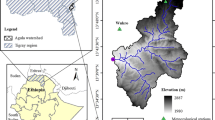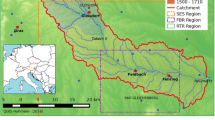Abstract
Watershed runoff modelling techniques were developed and applied for assessing climatic impacts, and tested for a watershed in the Northeast Pond River basin using atmospheric-change scenarios from a series of hypothetical scenarios. Results of this research strongly suggest that possible changes in temperature and precipitation caused by increases in atmospheric trace-gas concentrations could have major impacts on both the timing and magnitude of runoff and soil moisture in important natural resources areas. Of particular importance are predicted patterns of summer soil-moisture drying that are consistent across the entire range of tested scenarios. The decreases in summer soil moisture range from 10 to 50% for different scenarios. In addition, consistent changes were observed in the timing of runoff – specifically dramatic increases in winter runoff and decreases in summer runoff. These hydrologic results raise the possibility of major environmental and socio-economic difficulties and they will have significant implications for future water-resource planning and management.
Similar content being viewed by others
References
Bobba, A. G.: 1996, Environmental modelling of hydrological systems; Report No. 1014A and 1014B, Department of Water Resources Engineering, Lund Institute of Technology, Lund University, Lund, Sweden.
Bobba, A. G. and Lam, D. C. L.: 1985, Application of linearly distributed surface runoff model, Proc. Canadian Hydrology Symposium 15, 381–398.
Bobba, A. G. and Lam, D. C. L.: 1988, Application of hydrological model to acidified Turkey Lakes watershed, Canad. J. Fisheries Aquatic Sciences 45, 81–87.
Bobba, A. G. and Lam, D. C. L.: 1989, Application of hydrological model to acidified watersheds. A study on Mersey River and Moosepit Brook, Nova Scotia, Water, Air and Soil Pollution 46, 261–275.
Bobba, A. G. and Lam, D. C. L.: 1990, Hydrological modelling to acidified Canadian watersheds,J. Ecological Modelling 5, 5–32.
Bobba, A. G., Lam, D. C. L., Kay, D. and Ullah, W.: 1992, Interfacial a hydrological model with RAISON expert system, Water Resources Management 6, 25–34.
Bobba, A. G.: 1992, Application of hydrological model to a small Atlantic watershed, EOS, Trans. Am. Geophys. Union 73, 110.
Bobba, A. G., Jeffries, D. S., Singh, V. P. and Bengtsson, L.: 1994, Hydrologic characteristics and water balance of Eastern Canadian watershed due to climate change, EOS, Trans. Geophys. Union 75, 216.
Bobba, A. G., Singh, V. P., Jeffries, D. S. and Bengtsson, L.: 1997, Application of watershed runoff model to Northeast Pond River, Newfoundland, to study water balance and hydrological characteristics due to atmospheric change, Hydrological Processes 11, 1573–1593.
Flaschka, I. M.: 1984, Climatic change and water supply in the great basin, Master's Thesis, Department of Hydrology and Water Resources, University of Arizona.
Gleick, P. H.: 1986, Methods for evaluating the regional hydrological impacts of global climatic changes, J. Hydrol. 88, 99–116.
Hengeveld, H.: 1995, Understanding atmospheric change: a survey of the background science and implications of climate change and ozone depletion, 2nd edn, 1995. Environment Canada, State of the Environment Reporting, SOE Report No. 95–2.
IPCC (Inter Governmental Panel on Climate Change): 1990, Climate Change: the IPCC scientific assessment, Geneva, Switzerland:WorldMeteorological Organization and United Nations Environment Programme.
Lettenmaier, D. P. and Gan, T. Y.: 1990, Hydrologic sensitivity of the Sacramento-San Joaquim River Basin, California, to global warming, Water. Resour. Res. 26, 69–86.
Lins, H. F., Sundquist, E. T. and Ager, T. A.: 1988, Information on selected climate and climate change issues. US Geological Survey Open-File Report 88–718, USGS, Reston, Virginia, U.S.A.
Manabe, S. and Weatherald, R. T.: 1987, Large scale changes in soil wetness induced by an increase in carbon dioxide, J. Atmos. Sci. 44, 1211–1235.
Mather, J. R.: 1978, The climatic water budget in environmental analysis, D.C. Heath Co., Lexington Books, Lexington, Mass., U.S.A.
Miller, D. H.: 1977, Water at the surface of the earth: An introduction to ecosystem hydrodynamics, Academic, Orlando, Fla., U.S.A.
Mitchell, J. F. B.: 1989, The greenhouse effect and climate change, Rev. Geophys. 27, 115–139.
Panagoulia, D.: 1991, Hydrological response of a medium-sized mountains catchment to climate changes, Hydrl. Sci. J. 36, 525–547.
Panagoulia, D.: 1992, Hydrological modelling of a medium-sized mountainous catchment from incomplete meteorological data, J. Hydrol. 13, 29–310.
Panagoulia, D.: 1995, Assessment of daily catchment precipitation in mountainous regions for climate change interpretation, Hyd. Sc. J. 40, 331–350.
Revelle, R. R. and Waggoner, P. E.: 1983, Effects of a carbon dioxide induced climate change on water supplies in the western United States, In: Changing climate. Report of the carbon dioxide assessment Committee, National Academy of Sciences, National Academy Press, Washington, D.C., pp. 419–432.
Schwarz, H. E.: 1977, Climate change and water supply: How sensitive is the Northeast?, In: Climate change and water Supply, National Academy of Sciences, Washington, D.C., pp. 111–120.
Schneider, S. H. and Thompson, S. L.: 1981, Atmospheric CO2 and climate: Importance of the Transient Response, J. Geophys. Res. 86, 3135–3147.
Sokolov, A. A. and Chapman, T. G.: 1974, Methods for water balance computations, International Guide for Research and Practice, UNESCO Press, Paris.
Stockton, C. W. and Boggess, W. R.: 1979, Geohydrological implications of climate change on water resources development, U.S. Army Coastal Engineering Research Centre, Fort Belvoir, VA, U.S.A.
U.S. Army Corps of Engineers: 1980, Guide Manual for preparation of water balances, (R. J. Hayes, K. A. Poko and W. K. Johnson). The Hydrologic Engineering Centre, Davis, California.
U.S. Environmental Protection Agency: 1989, The potential effects of global climate change on the United States, Report to Congress, U.S. EPA, Office of Policy, Planning and Evaluation, Washington, D.C.
Author information
Authors and Affiliations
Rights and permissions
About this article
Cite this article
Bobba, A.G., Jeffries, D.S. & Singh, V.P. Sensitivity of Hydrological Variables in the Northeast Pond River Watershed, Newfoundland, Canada, Due to Atmospheric Change. Water Resources Management 13, 171–188 (1999). https://doi.org/10.1023/A:1008194330621
Issue Date:
DOI: https://doi.org/10.1023/A:1008194330621




